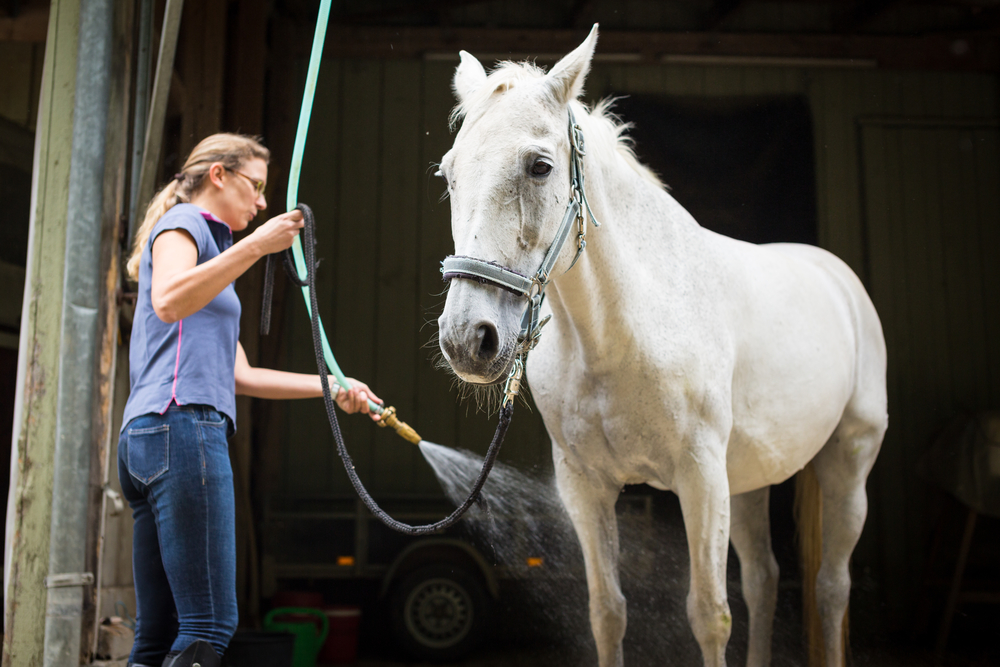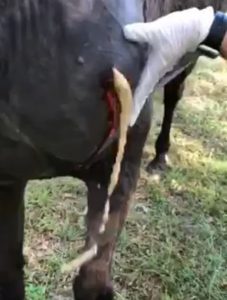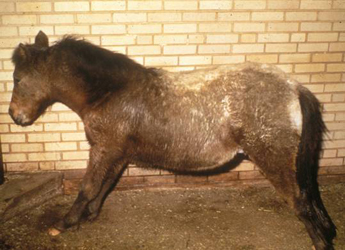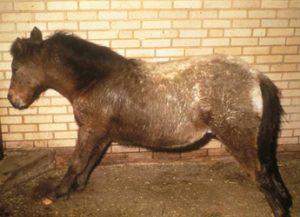
Nov 26, 2018 | Wound care
Proper Wound Care
Pus. I’m not going to lie: we have an unnatural reaction to pus around here. Especially large quantities of pus. The excitement when there’s a lot of pus potential is palpable. Phones come out with cameras at the ready, everyone gathers round, and the moment the scalpel nears the area, the crowd goes silent. I’m going to let you in on a little secret about why all this excitement happens the way it does: 99.9% of the time the horse is going to be OK, and so my Docs can revel in the joy of all that pus, while knowing that with a few simple care instructions this wound is going to heal.
Why all that pus?
 Let’s start with why there’s all that pus in the first place. Pus is a collection of dead fighters from the immune system (these are cells called neutrophils, lymphocytes, and mast cells), along with some serum (the liquid part of blood), and dead invaders. There’s a couple of reasons the body makes buckets of pus. The first is that the bacteria involved cause the immune system to really send in the troops. This is common with bacteria in the genus Streptococci in particular, and these guys live on normal skin, so they are around when wounds happen.
Let’s start with why there’s all that pus in the first place. Pus is a collection of dead fighters from the immune system (these are cells called neutrophils, lymphocytes, and mast cells), along with some serum (the liquid part of blood), and dead invaders. There’s a couple of reasons the body makes buckets of pus. The first is that the bacteria involved cause the immune system to really send in the troops. This is common with bacteria in the genus Streptococci in particular, and these guys live on normal skin, so they are around when wounds happen.
The second is a foreign body. Pieces of wood are a favorite foreign body for horses. Wood can be a fun combination of reason one and two since all those nooks and crannies in wood can hide a lot of bacteria. The third reason is that the body can’t overcome the infection, and keeps sending more and more immune system cells.
Minimizing pus
I have learned, in my years supervising here at the Clinic, that not every human feels the same excitement about pus as my Docs. In an effort to assist with this pus disdain, let’s talk about how to minimize pus production. It starts with a simple saying that I get rather tired of hearing from Dr. Lacher: Dilution is the solution to pollution. She means you’re going to get to spend a lot of time with a hose pointed at your horse’s wound. When a wound happens, all kinds of bacteria take advantage of the situation to invade. The body responds with white blood cells, and Voila! Pus. By gently rinsing a wound, you send those bacteria on their merry way to go wreak havoc elsewhere.
Wise Cat Tip: If the wound is actively bleeding, don’t start rinsing quite yet. Wise Cat Tip #2: Take a picture with your phone, and send it to my Docs. This lets them help you make decisions about proper care. Turns out you can use that phone for more than taking pictures of cats, and looking at pictures of cats, and watching cat videos. Who knew?
After hosing the wound for a good 10 minutes, apply an antibacterial ointment like triple antibiotic ointment. Do not go with whatever crazy goop you have laying around. Nearly all of the random lotions, potions, and ointments you have laying around are actually bad for wounds. My rule is if the Docs didn’t tell me to put something else on there, then triple antibiotic it is. As you know, cat rules are the highest rules of the land. They must be followed.

Keeping it clean
This is something I can really relate to, as a self-bathing creature. I like things clean. However, this doesn’t mean scrub a wound within an inch of its life. Gently cleaning with minimal soap once daily is all that’s needed. After soap, guess what? Run water over that wound for at least 10 minutes. After that, some triple antibiotic. If possible, a bandage, or even better, Sox for Horses covering a wound, which will help it heal significantly faster.
The bad news: horses love to cause injury to themselves. The good news: they do like to heal those wounds. With a little time, TLC, and water, most wounds will heal up great.
Now be a good human and subscribe to my blog below.
Your Fearless Feline Leader,
Tony
P.S. Want even more great horse knowledge? Tune in to the podcast the humans do called Straight from the Horse Doctor’s Mouth.
Tuesdays with Tony is the official blog of Tony the Clinic Cat at Springhill Equine Veterinary Clinic in Newberry, Florida. If you liked this blog, please subscribe below, and share it with your friends on social media! For more information, please call us at (352) 472-1620, visit our website at SpringhillEquine.com, or follow us on Facebook!
[jetpack_subscription_form title=”Subscribe to Tuesdays with Tony”]

Apr 2, 2018 | Lacerations, Tetanus, Vaccines, Wound care
A little housekeeping before we get started on Tetanus: don’t forget about my
Paddocks & Pastures Seminar on April 19th @ 6:00pm. Join me, the docs, and the Alachua County Extension Office to learn all you ever wanted to know about grass! The talk will be held right here at Springhill Equine, and as always, admission is FREE!
Now for this week’s enlightening blog. Continuing my trend of why we vaccinate horses for things, I decided to talk to you all about Tetanus today!
What is Tetanus?
Tetanus is a neurotoxin caused by the bacteria Clostridium tetani, which lives in the soil pretty much everywhere. Clostridium tetani likes to form spores that are very resistant to heat, drying, chemicals, and fire-breathing dragons. Ok, I got a little carried away there… but seriously, this bacteria can survive for years in the environment. More bad news: it is particularly common in horse manure. You know where you can find plenty of that? On horse farms!
Tetanus becomes a problem when it enters the body, usually through a wound or surgical incision. It is a myth that tetanus comes from sharp metal objects… it’s just that sharp metal objects tend to cause wounds which serve as a perfect entry point for this bacteria.
Once the organism enters the body, it begins to multiply *evil cat laugh*. Clostridium tetani loves anaerobic (oxygen-poor) environments, like the inside of a wound. The tetanus toxin travels through the bloodstream and binds to nerve endings at neuromuscular junctions. The toxin signals the muscle to contract, and the muscle gets locked in the contracted position.
What does Tetanus look like?

What this looks like is a horse with all 4 limbs stiffened (often called a “sawhorse” stance), a tight or locked jaw, and the third eyelid flashing across from the corner of the eye. The horse may be lying down with all 4 limbs extended, unable to stand. Eventually the tetanus toxin binds to the muscles used to breathe, leading to death.
In short, Tetanus looks very scary. Horses usually begin exhibiting signs within 24 hours of infection. The disease can progress over days to weeks, but is over 50% fatal. In order to survive tetanus, a horse must be rapidly treated with tetanus antitoxin, and managed with intensive supportive care (read: $expensive$). Even with treatment, horses often have long-lasting deficits from the tetanus infection.
If you suspect your horse may have tetanus, call your veterinarian immediately. Better yet, you should call your vet any time your horse suffers a wound that breaks the skin.
Is my horse at risk?
If your horse’s hooves ever touch the ground, then yes, he is at risk. If your horse lives on a horse farm full of tetanus-laden horse manure, then he is definitely at risk. If your horse lives on a horse farm, goes outside, and has access to sharp objects he could potentially cut himself on (this basically describes every horse I’ve ever met, and this cat has met a lot of horses), then he is at high risk for being exposed to tetanus at some point in his life.
In fact, as a human you are also at a pretty high risk of contracting tetanus. This risk is increased if you spend time outside and at the barn, which most of our clients do with most of their free time. If you are a human, you probably received a series of tetanus vaccines as a child. Even so, you will probably receive a tetanus booster vaccine if you have a serious wound and have not been recently vaccinated against tetanus.
“But Tony,” you may ask, “humans only need a tetanus booster like once every 5 years. Why do horses need boosters every 6 months?” Well, there are the high-risk factors discussed above (living outside in the dirt, having manure that is naturally full of tetanus). Then there is also the fact that nobody has ever studied exactly how long the protection of a tetanus vaccine lasts in horses. If you have a spare million dollars sitting around, you are welcome to fund such a study. Until then, I’m going to continue to err on the side of caution and recommend you vaccinate your horse once every 6 months.
How can I prevent Tetanus?
I thought you would never ask! Conveniently, there is a simple, inexpensive vaccine that is very effective at preventing tetanus in horses. Our docs recommended the vaccine twice a year in case your horse suffers a puncture wound or laceration. If we perform a surgery (such as castration) we will want to make sure your horse has been vaccinated against tetanus within the last 6 months. Reminder: that’s not because the docs dip their scalpel blades in Clostridium tetani before your horse’s surgery. It’s because cuts, even clean surgical ones, create a route for this bacteria that lives all around us to get inside the body.
When it comes to tetanus, an ounce of prevention is worth a pound of cure. Since the disease is often fatal, and treatment is very difficult, we feel strongly that it is well worth a $20 vaccine. For this reason, many of the combination vaccines we give include tetanus. Tetanus is the “T” in “EWT-WN” (Eastern/Western Encephalitis/Tetanus/West Nile) and “EWTR-WN” (Eastern/Western Encephalitis/Tetanus/Rhino virus/West Nile) vaccines. It just so happens that these other vaccines are also recommended every 6 months, so why not lump them all into one poke? If that’s not your style, and this post has inspired you, we do stock the plain Tetanus vaccine at the clinic as well.
So let’s all remember to call Shannon or MJ at the office to check when our horses are due for a tetanus booster, mmkay? Now I think I’ll go walk through some lovely tetanus-laden horse manure, and roll in some tetanus-flavored dirt! While I’m doing that, why don’t you scroll down a bit and subscribe? I’ll let you take a selfie with me at the next seminar if you do.
Until next week,
-Tony
Tuesdays with Tony is the official blog of Tony the Office Cat at Springhill Equine Veterinary Clinic in Newberry, Florida. For more information, please call us at (352) 472-1620, visit our website at SpringhillEquine.com, or follow us on Facebook!
[jetpack_subscription_form title="Subscribe to Whinny's Wisdoms"]

May 2, 2017 | Injuries, Lacerations, Wound care
Wound Care
The Shock and Awe Phase
You walk out to feed in the morning and are confronted with what you are sure is your horse’s leg hanging off a bloody stump. Go ahead and freak out for 30-60 seconds. It’s OK. We all do it. Now calmly catch your horse and walk over to the water hose. Begin hosing the wound and continue to hose it for at least 15 minutes. If possible, call Springhill Equine (I’m even going to give you the phone number right here: 352-472-1620 and the emergency line number in case it’s a weekend or after hours: 352-474-5007 ) while you are hosing. Even better, email or text a picture of the wounds to my Docs, and then call. If you can’t call while hosing, hose first, then call. My minions have a saying: dilution is the solution to pollution. Basically, the water dilutes out germs, dirt, and general nastiness.
The ‘Take Deep Breaths, it will be OK’ Phase
 Once you have hosed the wound for 15 minutes or so, put your horse somewhere quiet. We want them calm until one of my awesome Docs can get there. Do not apply any lotion, potion, or goop, no matter how many people tell you how great it works! It doesn’t matter that it worked great on that injury your great aunt’s cousin’s friend had. Each wound is different, and my Docs are the best people to decide which goop will be the best goop.
Once you have hosed the wound for 15 minutes or so, put your horse somewhere quiet. We want them calm until one of my awesome Docs can get there. Do not apply any lotion, potion, or goop, no matter how many people tell you how great it works! It doesn’t matter that it worked great on that injury your great aunt’s cousin’s friend had. Each wound is different, and my Docs are the best people to decide which goop will be the best goop.
Your horse is likely in pain at this point. We know you want to do something about that pain, but please wait to hear what my Docs have to say! They will direct you about which pain medication to use, and how much. Generally bute, Banamine, and Equioxx are the go-to choices to start with, but your horse’s medical history and the wound severity and location can change those choices. Once they assess the wounds, they will likely add some stronger drugs to help with pain.
Let the Healing Begin!
OK, you’ve hosed the wounds really well, a super awesome Springhill Equine veterinarian has taken care of your horse: now what? Less truly is more! Once again, I know you really, really, really want to put that super cool stuff in the blue bottle, or green tub, or white bottle on the wound. Vern down at the feed store said his friend’s niece’s cousin used it and it worked great. I promise you it didn’t and it won’t. Horses really, really want to heal wounds. They do it despite all the stuff we do to the wound, but if you want it to heal the fastest and the best, you need two things: pressure and moisture.
You can apply pressure the expensive, difficult way: non-stick pad to wound, gauze, elastikon, followed by a quilt or cotton, more gauze, and more elastikon or vetwrap. Or you can go with the easy way: Sox for Horses. My Docs spent a long time doing it the hard way. Now they do it the easy way! You may remember Coby, who fell through the trailer floor. My Docs began using Sox on that horse, and haven’t looked back. Your choice. As a typical cat, I pick easy every time.
Moisture can be applied many different ways, but I find they use plain old triple antibiotic ointment the most. For some wounds they will use a burn cream called silver sulfadiazene, but for most they tell you to go buy out CVS’s supply of triple antibiotic. In a few weeks, my Docs may adjust the topical ointment to add some steroid, but early on, simple is better.
So your plan: Cold hose for 10-15 minutes daily, apply triple antibiotic to wounds, replace sock.
The Real Story from The Top Cat
There are tons of pictures of amazing wounds that healed fantastic thanks to some lotion, potion, or goop. The truth is, horses heal despite all these products, not because of them. The most important parts of wound care are your diligent care and communication! If you aren’t sure about something, call the Doc! They eat, breathe, and sleep this stuff, and they are happy to talk you through your situation so that your horse gets the right care the first time.

 Let’s start with why there’s all that pus in the first place. Pus is a collection of dead fighters from the immune system (these are cells called neutrophils, lymphocytes, and mast cells), along with some serum (the liquid part of blood), and dead invaders. There’s a couple of reasons the body makes buckets of pus. The first is that the bacteria involved cause the immune system to really send in the troops. This is common with bacteria in the genus Streptococci in particular, and these guys live on normal skin, so they are around when wounds happen.
Let’s start with why there’s all that pus in the first place. Pus is a collection of dead fighters from the immune system (these are cells called neutrophils, lymphocytes, and mast cells), along with some serum (the liquid part of blood), and dead invaders. There’s a couple of reasons the body makes buckets of pus. The first is that the bacteria involved cause the immune system to really send in the troops. This is common with bacteria in the genus Streptococci in particular, and these guys live on normal skin, so they are around when wounds happen. 

 What this looks like is a horse with all 4 limbs stiffened (often called a “sawhorse” stance), a tight or locked jaw, and the third eyelid flashing across from the corner of the eye. The horse may be lying down with all 4 limbs extended, unable to stand. Eventually the tetanus toxin binds to the muscles used to breathe, leading to death.
What this looks like is a horse with all 4 limbs stiffened (often called a “sawhorse” stance), a tight or locked jaw, and the third eyelid flashing across from the corner of the eye. The horse may be lying down with all 4 limbs extended, unable to stand. Eventually the tetanus toxin binds to the muscles used to breathe, leading to death.
 Once you have hosed the wound for 15 minutes or so, put your horse somewhere quiet. We want them calm until one of my awesome Docs can get there. Do not apply any lotion, potion, or goop, no matter how many people tell you how great it works! It doesn’t matter that it worked great on that injury your great aunt’s cousin’s friend had. Each wound is different, and my Docs are the best people to decide which goop will be the best goop.
Once you have hosed the wound for 15 minutes or so, put your horse somewhere quiet. We want them calm until one of my awesome Docs can get there. Do not apply any lotion, potion, or goop, no matter how many people tell you how great it works! It doesn’t matter that it worked great on that injury your great aunt’s cousin’s friend had. Each wound is different, and my Docs are the best people to decide which goop will be the best goop.